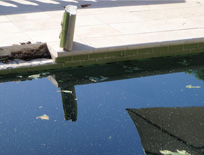Becoming Wise

“A smart man learns from his own mistakes, a wise man learns from the mistakes of others.”
If you follow that Latin proverb, then you might conclude that the watershaping industry is populated by a fair number of smart people and a few wise ones. There are others out there, however, who fall in neither of those categories — scores of builders and subcontractors who don’t even learn from their own mistakes let alone those of others.
These folks make the same sorts of mistakes over and over again, and, unfortunately, seem quite skillful at passing their insufficiencies on to their crews and, worse, to the next generation of construction professionals. It’s not a good situation.
To counter this tendency, our goal as an industry should be to cut off the repetition of bad practices by steadily evaluating what we do, and then upgrading our standards when common errors are identified. My own desire to do this within my company is why I’ve worked for the past 10 years as an industry expert in construction-defect complaints for the California State License Board.
This puts me out in the field, where I see hundreds of faulty details, and enables me to share what I observe with my staff so we can avoid making similar mistakes. It’s not that my staff and I never make mistakes, but that we do our best to learn from them and the mistakes of others.
Because I’ve witnessed so many of these bad practices over the years — and frankly, because they don’t seem to become any less frequent with time — I’ve decided to share my observations of common problems in a series of articles on this site entitled “Lessons Learned.” Someday, I intend to turn the articles into an educational textbook for the watershaping industry.
I also call on others to share their mistakes anonymously so we can all learn from each other. Please click on the link below to respond with your own stories and images.
Here’s hoping this series will help all of us avoid problems — and ultimately be counted among the ranks of the wise!
I’ll launch “Lessons Learned” with the following specific incident that exemplifies a whole class of related problems — and which in this case, sadly, had catastrophic results.
***
Scenario: As part of a remodeling project, the clients wanted to include an inch-and-a-half-thick Travertine coping to go with the Travertine decks that were being installed. This material was thinner than the original four-inch-thick, cantilevered coping, so the contractor floated a new top on the pool shell’s existing bond beam to bring the new coping up to the deck’s level in a smart-looking, bull-nosed edge detail.
For his part, the masonry contractor poured a new four-inch concrete base to support the new Travertine decking, then separated the deck from the coping using just an inch-and-a-half of a foam-based mastic joint — one of the most common details in all of swimming pool construction.
Problem: When installing the expansion joint between the deck and coping, the flexible material extended down only to the bottom of the Travertine. It did not reach down the additional four inches required to separate the deck’s sub-base from the shell and its newly applied bond-beam extension. Thus, when the concrete expanded in warm weather, it pressed against the revamped beam and broke it at the cold joint.
This created a large crack at the waterline, thereby allowing the pool water to leak into the surrounding soil. That’s often a big problem, but in this case it was utterly huge: The water saturated the ground supporting an adjacent retaining wall that held up the whole pool area. By the time I inspected the site, hydrostatic pressure had pushed the wall a full 10 inches off plumb and damaged a tennis court on a neighboring property.
When all was said and done, remediating the issue cost the offending pool remodeler $160,000.
Lesson Learned: This and similar situations are so tragic because they can be prevented so easily. The entire deck structure — including both the surface material and its concrete base — must be properly separated from the shell and coping by a simple, half-inch-wide expansion joint packed with foam and topped with mastic. All this for an up-front cost of about $20!
Scott Cohen is president and supervising designer of The Green Scene, an outdoor design and construction firm based in Canoga Park, Calif. He provides consultation for clients nationwide and gives seminars on designing landscapes, swimming pools and outdoor kitchens. For more information, visit www.greenscenelandscape.com.










